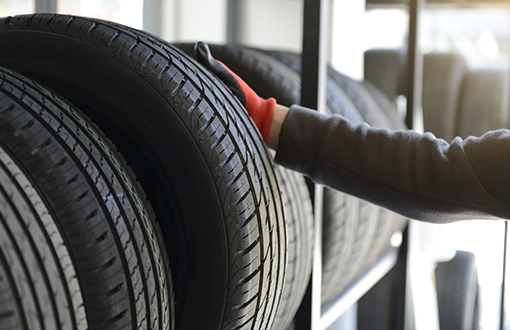No items in cart right now!
Working Hours - 8 AM To 8 PM
 March 07
March 07
The wheel tyre constitutes one of the essential elements that make up a vehicle. Cars function safely and move smoothly because of tyres. The passage of time results in tyre deterioration. This is called tyre wear. Rubber tread age develops from various causes, although poor road quality stands out as the primary contributing element.
Roods present two distinct characteristics, including well-paved surfaces as well as damaged sections with cracks and potholes. The present state of roadways determines the speed of tyre degradation. Frequent travel on bad roads inhibits your tyres from reaching their normal lifespan. The following text explains which types of roads accelerate tyre wear and provides strategies to maintain proper tyre condition.
Tyres experience varying effects based on which type of road vehicle operators select. Several streets have different levels of surface hardness. Some roads both shorten and extend the lifespan of tyres in your vehicle. This article examines the multiple effects that different road surfaces generate upon your vehicle tyres.
Smooth Asphalt Roads
Roads with Potholes
Gravel and Dirt Roads
Wet and Slippery Roads
Concrete Roads
Typical asphalt surfaces deliver the best possible performance for tyres. The flat tyre surface enables better contact between the tyre and the road surface. The maintenance of tread depth improves when this happens, thus extending the total lifespan of the tyre. Operating tyres on sizzling asphalt at high levels of friction may result in slight tyre wear but will not damage them permanently.
The wheels experience unusual pressure when a vehicle encounters road potholes during movement. Uneven tyre wear and damage to the tyre walls result from this type of road condition. Driving with massive potholes produces dangerous situations because they can cause your tyre to face a sudden blowout.
Traveling on roads made of gravel and dirt leads to upsetting terrain surfaces that damage tyres. The tyres endure excessive work due to this condition, which results in a faster reduction of tread depth. The tiny rocks embedded in such pathways damage tyre surfaces through small cuts that shorten the tyre's operational life.
The performance of tyres becomes negatively affected by slippery road conditions. More slips become probable under these conditions. Aggressive tyre slipping causes premature tyre exhaustion. The entry of water through small tyre imperfections gradually disintegrates the tyre material because of prolonged exposure.
Concrete roads possess greater hardness than asphalt roads do. Excessive friction generated by the tyres shortens their lifespan. Due to their smoothness levels, tyres experience lesser damage on concrete roads as compared to gravel roads.
Do you want to make your tyres last longer? Follow Etarat Online and get tyre wear tips from experts. Keep your tyres in perfect shape with experts by your side!
A tyre faces different patterns of wear when it loses its material. The parts of a tyre do not diminish at similar rates. Different types of tyre wear patterns can be observed due to the following causes.
Centre Wear
Edge Wear
Cupping Wear
Feathering Wear
Patchy Wear
The typical tyre wear pattern that develops when the middle area deteriorates at a quicker pace compared to the tyre edges is known as centre wear. Anti-hazards happen when tyres receive excessive air pressure. Excess air pressure leads the centre of the tyre to come in contact with the road often and thus results in rapid wear.
The sides of the tyre experience accelerated wear compared to the rest when we refer to edge wear. An underinflated tyre condition produces this type of wear. A tyre's reduced air pressure enables its sides to apply more force onto the road surface, which leads to edge tyre wear.
Small dip-shaped indentations similar to cups form when cups develop on a tyre. When car suspension malfunctions, the tyres will experience this issue. A faulty suspension system lets the tyre bounce excessively until it creates an uneven tread depth.
The tyre develops feathering wear when its tread shows one side as harsh while the other side remains smooth. The wheel alignment should be checked to prevent this condition from occurring. The practice of tyre rotation results in the prevention of this specific wear pattern.
Part of the tyre surface experiences accelerated wearing in contrast to other regions. Poor tyre balance leads to the development of this issue. Numerous braking episodes performed at high intensity levels can result in this phenomenon.
Keep your tyres in perfect shape with Etarat Online! Contact us now and get expert tips regarding tyre wear and other maintenance tricks!
Road conditions play a big role in tyre wear. Driving on smooth asphalt roads helps tyres last longer, while rough roads with potholes can wear them out quickly. Regular tyre rotation and checking the tread depth can help keep tyres in good shape. If you want quality tyres that last, check out Etarat Online for the best deals and services!
Road conditions combined with tyre pressure and improper driving habits lead to the greatest tyre wear.
Testing your tread depth each month is necessary to determine the safety of your vehicle while driving.
Your tyres will suffer damage and develop uneven destruction from encountering potholes on the road.
leave a comment